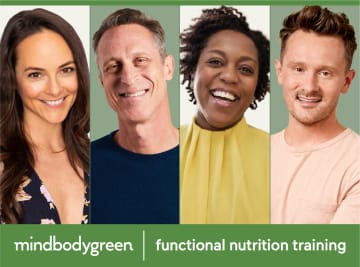But here’s the reality: Plant-based and vegan diets are not actually synonymous. While vegan diets are generally plant-based, plant-based diets are not, by definition vegan. To offer some clarity, we tapped two registered dietitians to get the scoop on these popular diets—including what they are, what foods they include, and what benefits you can expect. According to The Vegan Society, the word simply came from the first three and last two letters of “vegetarian.” This includes obvious foods like meat, poultry, and fish—in addition to animal products like eggs, dairy, and even honey, explains plant-based registered dietitian and owner of Plant-Based Eats, Amy Gorin, M.S., RDN. Most vegans will also eliminate animal-based products beyond diet—such as leather or fur goods, products that use any animal-derived ingredients (think beeswax or gelatin), or anything that involves animal testing. In addition to the animal welfare concerns, many vegans also choose this lifestyle due to the environmental impact of factory farming, or the health benefits of swapping in more plant foods. That said, it’s important to note that not all vegan diets are healthy ones. “The vegan focus is usually set on avoiding animal products, but the priority is not placed on unprocessed plant-based, whole foods,” Miranda Hammer, M.S., R.D., CDN, previously told mbg (think faux meat or processed snacks). The primary requirement for a “vegan” label is the exclusion of animal products—the health and well-being benefits are really contingent on how someone chooses to practice the diet. “Ideally, a plant-based diet is one that puts actual plants forward on the plate—think fresh produce, whole grains, plant-derived fats, nuts, legumes, and seeds,” says Nicole Rodriguez, RDN. The term “plant-based” was introduced in the 1980s, by T. Colin Campbell, Ph.D.—a researcher at the National Institutes of Health (NIH) at the time—to describe a vegetable-based diet that focuses on health rather than ethics. Even though plants are the priority in this eating style, it’s a very flexible concept—meaning it’s certainly possible to be “plant-based” while still including meat, fish, eggs, and dairy. As Hammer explains, “For plant-based eaters, animal proteins can happily fit into the lifestyle, yet they typically serve as more of a supporting role to your veggies and whole grains.” In addition to being a healthy eating mindset, Gorin says plant-based diets help you feel fuller and more satisfied because you’re eating more fiber and more volume. By increasing the number of plants in your diet, you’re also likely to provide your body with an array of vitamins, minerals, antioxidants, and phytochemicals1. One common concern for both vegan and vegetarian diets is whether you can really get enough nutrients. Hammer reassures it’s more than possible: “As long as you’re consuming a healthy balance of protein, vegetables, fruits, and other fiber-rich, whole-food carbs, there’s no reason you shouldn’t get the vitamins and nutrients your body needs.” At the same time, this style of eating avoids or minimizes highly processed foods—such as bleached flour, refined sugar, and refined oil. People who follow a whole-foods, plant-based diet often minimize animal products, as well. Nutrition and well-being are the cornerstones of this eating style. As Gorin describes: “This is the healthiest type of plant-based diet that you can follow.” When plants are the emphasis, both diets offer nutritional benefits, too. “When you’re eating more plants, you’re taking in a variety of vitamins, minerals, and antioxidants,” Gorin says. You’ll also likely add more fiber to your diet, which can help promote digestion and gut health, support steady blood sugar levels, maintain energy, and keep you feeling satiated. “These nutrients can help lower your risk of chronic disease like type 2 diabetes2 and heart disease,” says Gorin. In fact, one study of over 10,000 adults published in the Journal of the American Heart Association indicated those who followed a plant-based diet had a 16% lower risk of having cardiovascular disease and a 32% lower risk of dying of cardiovascular disease. What’s more, swapping meat in favor of more plants can help lower blood pressure3 and cholesterol. Although often in moderation, a plant-based diet may include animal products such as meat, fish, dairy, and eggs. However, by definition, a vegan diet excludes all animal products. However, while plant-based diets put health at the forefront, technically that’s not the basis of a vegan diet. So while a bag of chips may qualify as “vegan,” that processed snack may not fit into a plant-based lifestyle. (Yes, we’re getting very precise here.) With that being said, one’s dietary pattern is personal, and many vegans certainly let ethics, nutrient density, and health benefits collectively drive their nutrition lifestyle. She continues that someone who eats a plant-based diet may consume some eggs, dairy products, and occasional meat—all of which are off-limits in a vegan diet. Gorin says wine and honey are also examples of plant-based, but not necessarily vegan, food items. “Honey is [usually] not part of a vegan diet because the health of the bees that produce honey may be harmed through conventional honey production,” she says. And a standard bottle of wine uses a clarification process that uses animal-based products (like casein, albumin, gelatin, or isinglass). “If you’re looking for a vegan wine, there are many out there that use alternative ingredients for this process.” Both diets are full of nutritional benefits that we can all benefit from, so it really comes down to individual preference. To get you started on a more plant-forward journey, reference this thorough vegan, plant-based grocery list the next time you head to the store or farmers market.




